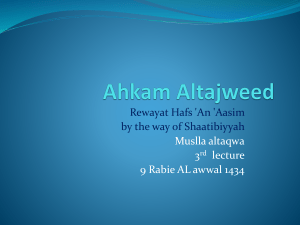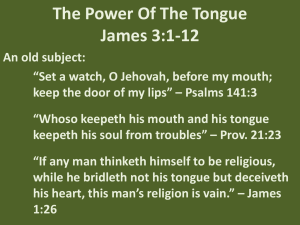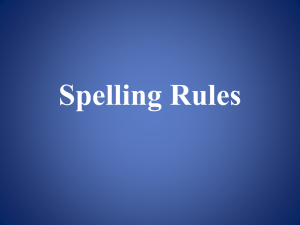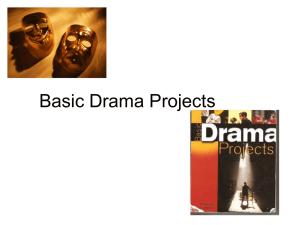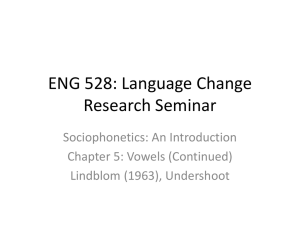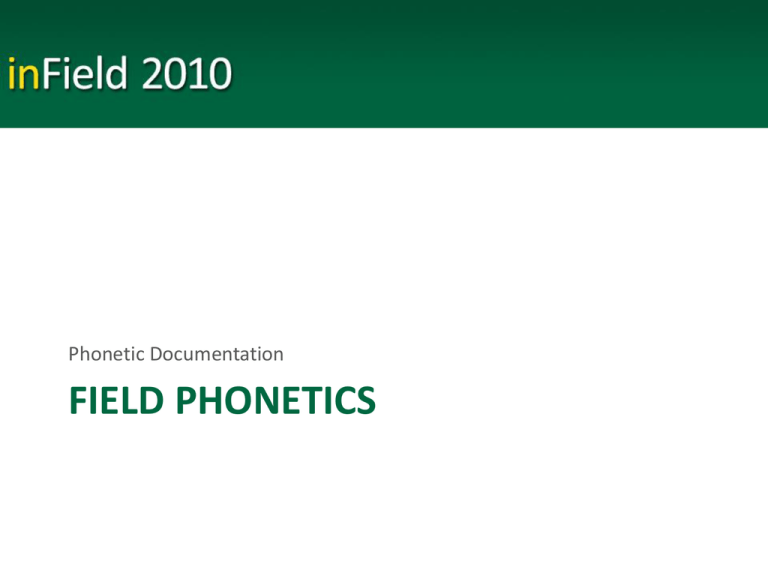
Phonetic Documentation
FIELD PHONETICS
Phonetic Documentation
• Describe the inventory of a language in a
phonetically accurate way.
• If the phonetic description is not accurate, it is
difficult to compare to other languages
(typologically, historically, synchronically), and
to have the phonological patterns make sense.
• To make an orthography that “sounds like the
language when you read it out”
Why phonetic fieldwork?
• Transcriptions are influenced by the native
language of the fieldworker (Strange 1995).
Discovering Place of Articulation of
consonants
InField 2010
University of Oregon
Dr. Amanda L. Miller
Place of Articulation
• Articulatory Photography:
– Palatography / Linguography
– Lip photography (still or video)
• Acoustics of Stops:
• Locus Equations (F2 Onset, F2 Mid)
• Voice Onset Time
Acoustics of Fricatives:
• Spectral moments
• Spectral peaks
Phonetic features
Palatography
• By doing palatography, you can discover the
exact place of articulation of a consonant, by
seeing where black mixture on the tongue
makes contact with the palate.
Places of Articulation
Palatography/ Linguography
• Materials needed:
– Dental mirror(s) – different sizes for different sized
mouths, fog-proof mirror is quite helpful
– Child’s paintbrushes or q-tips
– Activated Charcoal (can substitute with jello
mixture)
– Olive oil (can substitute with other types of oil if
olive oil is not available)
– Dish soap to clean dental mirror between each
production, and sink or plastic tub / dishpan to
wash mirror
Palatography / Linguography
• Materials needed (continued)
– Mixing bowl (disposable, as it is hard to remove
charcoal mixture, a fresh one for each consultant)
– Dish towel or apron to drape over consultant’s
clothes to prevent from dirtying them
– Lemonade or other citrus fruit for subjects to
drink / eat to remove charcoal mixture, and fresh
glass for each consultant (Fresh pineapple works
wonders!, fresh oranges are not so good)
Palatography / Linguography
Materials needed (continued)
– Digital camera, able to set to take good pictures in
dark settings
– Flashlight may be used to light up inside of mouth
if camera cannot be adjusted for dark spaces
– Plastic table cloth to avoid getting charcoal
powder everywhere
– Digital recorder to capture audio of the
productions
– Notebook to keep record of picture number /
sound file number for each word
Palatography / Linguography
Other tips:
• You can have the consultants paint their own
tongue with a mirror, especially if there is
sensitivity to having an unknown person , or
person of different sex inside of someone’s
mouth
• It is best to do palatography / linguography outside,
so that consultants can spit out charcoal mixture
freely (alternatively you can be near a sink / tub, but
this gets kind of gross).
Palatography
• Take a photo of the palate first without any
charcoal mixture, so that you have a record of
any dark spots on the teeth, etc.
Palatography
• Develop a wordlist
– [a] vowel context on both sides is best because the tongue
doesn’t approach the palate
– bisyllabic words with the target consonant intervocalic, or
bisyllabic with initial consonant
– No other consonants, unless they are labial
– Try to use real words. If the language has long words, you
can ask the consultant to produce only the first syllable of
a longer word.
– Use minimal sets wherever possible
– Keep prosodic positions the same (tone probably won’t
effect articulation, though stress might).
Palatography
• Mix the activated charcoal and olive oil
• If mixture is correct texture, it will cover the
tongue well, and not slide off (except for some
consultants who salivate a lot)
• Paint the tongue with the mixture using a
child’s paintbrush (Ladefoged 200X ) or q-tip –
make sure it covers the tongue completely,
nice and dark with no pink spots showing.
• Paint as far back on the tongue as you can
without gagging your consultant
Palatography
• Have the consultant produce the
syllable/word in question, slip the dental
mirror in their mouth, and take a picture of
the palate.
• Consultants can produce the word / syllable
multiple times as long as they don’t speak
other words or swallow or touch their palate
with their tongue in between productions)
• Have the consultant rinse their mouth with a
citrus drink to remove the charcoal mixture.
Palatography: A Recent
Discovery
• Fieldwork on Grootfontein !Xung in Namibia
Claims for a retroflex click
• Doke (1926) was the first to document a retroflex click
• described !Xung spoken in Grootfontein area as having a
5th contrastive coronal click, the retroflex click
• Snyman (1997) survey of !Xung lects
• also described !Xung spoken in Grootfontein area as
having a 5th retroflex click
• König and Heine (2001) describe Ekoka !Xung as having
four contrastive clicks: dental, alveolar, lateral, and
retroflex (no palatal click)
• admit that they do not know what the fourth click is
phonetically
18
Claims against a retroflex
click
• Currently, the IPA recognizes only 4 coronal clicks: dental, alveolar,
lateral, and palatal
Dental
Alveolar
Lateral
alveolar
palatal
|
!
||
ǂ
c
q
x
qc
• no petition has ever been made to include the retroflex click in the
IPA
• Heikenen (1986) described the !Xung spoken in the Ekoka area as
having a palatal, rather than retroflex, click
• In Sounds of the World’s Languages (1996) Ladefoged and Maddieson
state they do not believe a retroflex click to exist, based on the lack
of evidence
19
!Xung is spoken in Namibia and
Angola
20
!Xung Lects
König and Heine (2001)
Map
21
Phonemic Inventory: Ingressive
Consonants
/Palatal
Doke (1926)
22
Grootfontein !Xung alveolar vs
retroflex:
palatography
g!u ‘belly’
speaker KU
g!!u ‘water’
speaker KU
23
Linguography
• Linguography is when you paint the palate
with the same charcoal / olive oil mixture,
have the consultant produce a one syllable Ca
word or bisyllabic aCa word, and see where
the mixture rubs off on the tongue.
Linguography
• Linguography tells you whether a sound is
apical (produced with the tip of the tongue),
laminal (produced with the blade of the
tongue), dorsal (produced with the tongue
dorsum) or subapical (produced with the
underside of the tongue touching the palate).
Parts of the tongue
Linguography: A Recent
Discovery
• Fieldwork in Grootfontein and Ekoka, Namibia
Grootfontein !Xung alveolar vs
retroflex:
linguography
g!u ‘belly’
speaker KU
g!!u ‘water’
speaker KU
28
Ekoka reported retroflex vs
Grootfontein palatal
Grootfontein
gǂa ‘to be
old’
speaker XT
Ekoka
g!!a ‘to be old’
speaker DX
29
Lip photography
• Tells you the degree of constriction
• Provides information about the type of labial
constriction: bilabial, labio-dental, linguolabial
• Provides information about the gestural type
involving the lips: protruded, or compressed
Lip photography
• It is good to get photographs from two angles
(straight on, and from the side).
• This can be done with one camera and a
mirror, to get both images from the same
production.
• You can take still photographs (timing can be
tricky), 30 fps video, high frame rate video
Lip photography / video
Acoustics of Stops: Place of
articulation
• You can also use acoustics to determine place
of articulation of stops.
• Acoustics is easier to collect, non-invasive, but
you need multiple repetitions, and it takes
longer to analyze.
• Locus Equations can be used to determine
place of articulation, and to uncover language
specific C-V coarticulation patterns (Everett
2008).
General tips for Acoustic
Recordings
• Head mounted microphones are quite good, because they
keep the mike in the correct position (to the side of the
mouth to avoid puffs of air), and keep it locked in the same
position throughout the recording session (Shure SM10A with
preamp like the USBPre, or Plantronics microphones).
• You need a microphone with a good frequency response (80
Hz to 11,000 Hz).
• Avoid background noise (use windscreen, away from other
people, village)
• Be sure to put an audio marking of what the recording is – the
speaker’s name, location of recording, language, etc.
• 22050 Hz sampling rate is sufficient (there is nothing
measurable above 11,025 Hz)
General tips for acoustic
recordings
• Record the whole wordlist, then repeat the whole
thing (this way if the voice changes it changes for the
whole list – not for some words on the list).
• You need at least 10 repetitions of each consonant in
each context to do statistics, and 15 gives you some
room for recordings that aren’t usable – clipped, etc.
• You can five repetitions of 3 words, 3 reps of 5
words, or 15 reps of 1 word, as long as it’s consistent
across the types.
General tips for acoustic
recordings
• Label your recordings in Praat, and write a
script to analyze the data (or find one on the
web).
• You can record people for acoustics who may
not be the best subjects for articulatory
studies.
• Spread the work out among the consultants,
so more people get to work.
Formant transitions in three
synthetic stop consonant
continua
• Produced with the
‘pattern playback’
synthesiser.
• The ‘steady-state’ F1
and F2 patterns
determine the vowel.
•The formant transitions
constitute context
sensitive cues to place of
articulation of the stop.
• Is there a common
property that defines a
given place of articulation
in terms of formant
transitions?
The ‘locus’ of a formant transition
• Figure shows steady
state F2 for different
vowels and their
formant transitions for
[d] (alveolar stop)
• The formant transitions
point back to a common
‘locus’ at 1.8 kHz.
The ‘locus’ of a formant transition
• The ‘locus’ of F2:
– 3 kHz for velars
– 1.8 kHz for alveolars
– .6-.8 kHz for labials.
• However, the locus is a
somewhat idealized notion.
• Velar stops vary in place of
articulation with different
vowels.
Summary: cues to place of
articulation in stop consonants.
• Spectral energy distribution in the noise burst
and formant transitions are the main cues.
• Formant transitions are context-sensitive cues.
• Context-sensitive cues require more complex
signal processing.
• A need for specialized phonetic feature
detectors?
Locus Equations
• Record multiple repetitions of each stop in all vowel
contexts.
• Locus equations are linear regressions based on F2
formant transitions from vowel onsets to vowel
midpoints.
• The F2 value of the onset of a given vowel can be
plotted on the y-axis, with the F2 value of the vowel’s
midpoint plotted on the x-axis.
• Has been used to document C-V coarticulation
patterns of consonants in Karitiana (Amazonian
language, Everett 2008).
Locus Equations
Linear regression equations derived from a two dimensional plot
For any given consonant, the F2 onset for the consonant is
plotted against the F2 target of the vowel on the x-axis
(usually at the midpoint of the vowel).
Y = mx + c
where m is the slope of the line, and c is a constant.
The linear behavior of locus equation data is best explained by
the theory that the vowel gesture begins before the release of
the consonant (Ohman 1966).
What do they tell us?
• Locus equation slopes correlate with the place of
articulation of the consonant.
• The slope allows us to assess the degree of
coarticulation between the vowel and the
consonant.
• Different languages may also show differences in
degree of coarticulation.
(see Beddor et al.2002)
Measuring Formants
F2 SCATTER PLOTS
Locus Equations: Kiritiana
Slope correlates with POA
POA: Cairene Arabic
Slope and Y-Intercept
Locus Equations: Crosslinguistic comparisons
References
Anderson, Victoria. (2008). Static Palatography for Language
Fieldwork. Language Documentation and Conservation 2, 1, 127.
Everett, Caleb. (2008). Locus Equation Analysis as a Tool for
Linguistic Fieldwork. Language Documentation and
Conservation 2, 2, 185-211.
Ladefoged, Peter. (2003). Phonetic Data Analysis: An
Introduction to Fieldwork and Instrumental Techniques.
Malden, MA: Wiley-Blackwell.
Ladefoged, Peter. (2007). Articulatory features for describing
lexical distinctions. Language 83 (1). 161-180.
Ladefoged, Peter and Maddieson, Ian. (1996). Sounds of the
World’s Languages. Blackwell.
References
Ladefoged, Peter. (1957). “Use of Palatography”.
Journal of Speech and Hearing Disorders. 22.5,
764-774.
OSU Complete Denture Clinic Manual.


